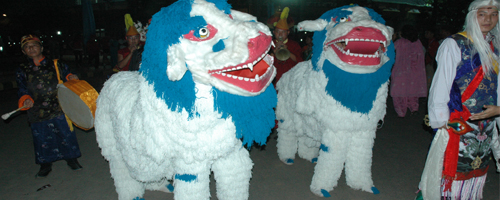Friday, April 19, 2013 | 1:53:00 AM

Singhi Chham is a folk dance which is also known as Loin Dance is very popular in the Indian state of Assam. It is especially associated with the Bhutias of Sikkim. It is mostly performed in the month of September to show their gratitude towards the third highest peak Kanchenjunga. This mountain range looks like a white loin in the snowy season which guards the state form unwanted hazards. This magnificent dance is also a representation of their culture. This is an ancient dance form which originated about two and a half centuries ago.
There are two artists needed to perform this dance. They have to get inside the costume of the lion. One artist is at the front part. It is the head of the lion. Second is at the back. The legs of the dancer positioned on the front become the two forelegs of the lion and the two legs of the dancer positioned at the back form the hind legs. In addition to that they have to wear a costume that weighs approximately eighteen kilograms. There is also a ring master. This dance is only performed by the male artists. The faces of the artist are not displayed during the performance so it is also known as masked lion dance. Usually two to four lions are used during the performance. Each dummy lion is made of white fur and the face is blue in colour.
This dance is a challenge for the artists because they have to perform many different types of movements during the performance. They have to sit, at another instant they have to jump, next they have to turn around and move in a circle. These movements require a lot of co-ordination between the two artists. They have to spend long hours during the dance rehearsals. It takes two to three months to become an expert of the dance.
The musicians play instruments like yangjey (which looks like a santoor), cymbal and gna (drum). Sometimes only a drum is used for the music during the whole performance.
The musicians and the ringmaster wear colourful costumes which include three robes, one on top of the other, a special boot and a cap.
The sikkimese people believe that if one sights the animal, it brings good luck. This dance represents the cultural aspect and faith of the people living in this state.
Posted By Desievite Admin

